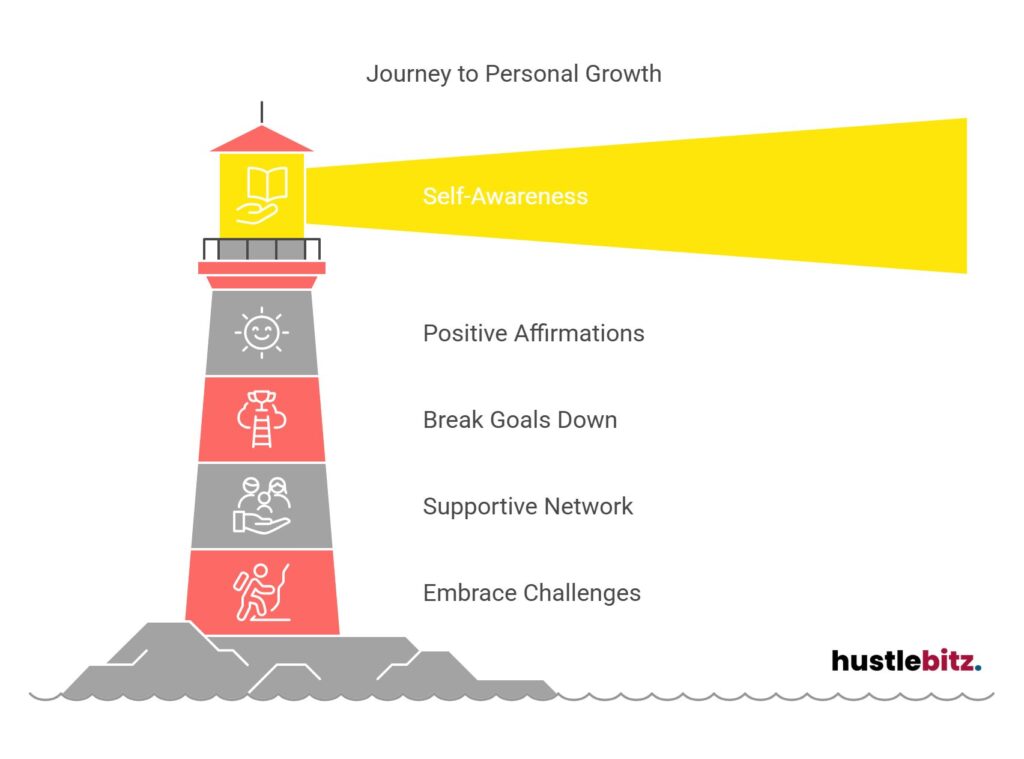Overcoming self-limiting beliefs is crucial for personal growth and realizing one’s full potential. These beliefs often stem from past experiences and can manifest as feelings of inadequacy or fear of failure. They create mental barriers that hinder progress and stifle creativity. To combat these beliefs, individuals should practice self-awareness, challenge negative thoughts, and adopt empowering narratives. Techniques such as positive affirmations and visualization help in reshaping one’s mindset. By reframing challenges as opportunities for growth, you can foster resilience. Exploring further can provide you with additional strategies to enhance your personal development journey.
Key Takeaways
- Practice self-awareness and reflection to identify and understand your self-limiting beliefs and their origins.
- Use positive affirmations and visualize success to reinforce empowering thoughts and cultivate a positive mindset.
- Break goals into small, achievable steps to build confidence and demonstrate progress toward overcoming challenges.
- Surround yourself with supportive individuals and engage in growth-focused communities for motivation and accountability.
- Embrace challenges as learning opportunities, reflecting on setbacks to foster resilience and continuous improvement.

Understanding Self-Limiting Beliefs

Self-limiting beliefs are deeply ingrained perceptions that inhibit personal growth and potential, often rooted in past experiences and societal expectations. These beliefs manifest as negative thoughts that convince individuals they are incapable of achieving their goals or deserving of success. Recognizing and understanding these self-limiting beliefs is the first step towards breaking free from their constraints.
To identify self-limiting beliefs, individuals must engage in introspective practices, such as journaling or meditation, which can reveal underlying thought patterns. Common examples include beliefs about one’s intelligence, capabilities, or worthiness. It is essential to scrutinize the origins of these thoughts, as they often stem from childhood experiences or cultural norms that dictate what is possible or acceptable.
Overcoming these beliefs requires a deliberate effort to challenge and reframe negative thoughts. It involves replacing self-doubt with affirmations of self-worth and potential. This process can be facilitated through therapy, coaching, or supportive peer networks that encourage personal growth. By confronting and dismantling self-limiting beliefs, individuals can foster a more empowering mindset, paving the way for transformative change.
Ultimately, understanding self-limiting beliefs is crucial for anyone seeking to enhance their personal growth. By recognizing the barriers they impose and committing to overcoming these beliefs, individuals can unlock their full potential and pursue their aspirations with renewed confidence and vigor. This journey not only enriches individual lives but also contributes to a more positive and empowered community.
Common Types of Self-Limiting Beliefs
Identifying the various forms of self-limiting beliefs is key to understanding how they can impede personal and professional development. These beliefs often manifest as pervasive negative thoughts that undermine one’s confidence and potential. Common types include the belief in personal inadequacy, where individuals convince themselves they lack the necessary skills or intelligence to succeed. This can lead to missed opportunities for growth in both personal and professional spheres.
Another prevalent self-limiting belief is the fear of failure. Many individuals hesitate to pursue goals, fearing that any attempts will result in disappointment. This mindset not only stifles ambition but also prevents individuals from embracing challenges that could lead to substantial personal growth and success. Additionally, beliefs that are holding individuals back often include comparisons to others, which can foster feelings of inferiority and self-doubt.
It is also important to recognize the “imposter syndrome,” where successful individuals attribute their achievements to luck rather than their abilities. Such beliefs can create a cycle of self-doubt that hinders further progress.
To overcome self-limiting beliefs, it is essential to challenge these negative thoughts with positive affirmations and a mindset geared toward growth. By reframing one’s perspective, individuals can open themselves to opportunities for growth that they previously deemed unattainable. Recognizing and addressing these common self-limiting beliefs is a crucial step toward unlocking one’s full potential and achieving lasting personal growth.
The Impact on Personal Growth

Consistently harboring self-limiting beliefs can significantly hinder an individual’s personal growth by creating mental barriers that prevent the pursuit of new experiences and opportunities. Such beliefs can stifle creativity, diminish motivation, and create a sense of stagnation, ultimately obstructing personal development. To foster a growth mindset, it is essential to recognize and overcome these limiting beliefs, allowing individuals to unlock their full potential.
Employing effective strategies to overcome limiting beliefs is crucial for personal growth. The following table outlines common self-limiting beliefs, their impact, and strategies to overcome them:
| Self-Limiting Belief | Impact on Growth | Strategy to Overcome |
| I’m not good enough | Low self-esteem and missed opportunities | Affirm personal strengths and successes |
| Failure is unacceptable | Fear of taking risks and trying new things | Embrace failure as a learning opportunity |
| Change is too difficult | Resistance to personal transformation | Break goals into smaller, manageable steps |
Identifying Your Limiting Beliefs

Recognizing the specific beliefs that hold us back is a crucial step toward fostering personal growth and achieving our full potential. Identifying thoughts that contribute to self-limiting beliefs requires a commitment to self-awareness and reflection. These thoughts and beliefs often manifest as negative self-talk, doubts, or fears that prevent us from pursuing our goals.
To effectively overcome your limiting beliefs, start by paying attention to recurring patterns in your thinking. Ask yourself questions like, “What do I believe about my abilities?” or “What fears are preventing me from taking action?” Documenting these thoughts can provide clarity and help you recognize how they are rooted in past experiences.
Many limiting beliefs originate from childhood, societal expectations, or past failures, and they can shape our perceptions of what is possible. By identifying these beliefs, you can begin to understand how they influence your behavior and decision-making.
Additionally, consider the emotional triggers associated with these beliefs. When do you feel the most self-doubt? Recognizing these triggers allows you to create strategies to manage them effectively.
Challenging Negative Thoughts

Challenging negative thoughts involves actively questioning their validity and reframing them to foster a more empowering mindset. This process is crucial for personal growth, as negative thoughts often stem from deep-seated beliefs that limit our potential. To effectively challenge these thoughts, it is essential to recognize them as temporary perceptions rather than absolute truths.
One of the most practical steps in this process is to engage in positive self-talk. By consciously replacing negative narratives with affirming statements, individuals can begin to shift their mindset. For instance, instead of thinking, ‘I will fail at this task,’ one might reframe that thought to, ‘I have the skills and resources to succeed.’ This simple shift not only alters one’s emotional state but also enhances motivation.
Another effective method for challenging negative thoughts is to maintain a thought journal. Documenting negative beliefs and their corresponding reframed versions helps in recognizing patterns and triggers. With practice, this habit can create a robust framework for understanding beliefs and how to overcome them.
Furthermore, sharing these thoughts with a trusted friend or therapist can provide additional perspectives and insights, reinforcing a more positive outlook.
Replacing Beliefs With Empowering Thoughts

Replacing self-limiting beliefs with empowering thoughts is a transformative process that fosters resilience and opens the door to new opportunities for personal and professional growth.
This journey begins with the critical task of identifying thoughts that limit our potential. By recognizing and understanding these negative beliefs, individuals can start the process of replacing negative thoughts with more constructive, empowering alternatives.
To effectively replace self-limiting beliefs, consider the following strategies:
- Practice positive affirmations: Regularly repeating affirmations can reinforce new beliefs and encourage a positive mindset.
- Visualize success: Envisioning yourself overcoming obstacles helps solidify the belief in your capabilities.
- Surround yourself with positivity: Engage with uplifting individuals who inspire growth and support your journey.
- Keep a growth journal: Documenting your thoughts, experiences, and progress can provide clarity and motivation.
- Set small, achievable goals: Breaking down larger objectives into manageable steps can help build confidence and demonstrate progress.
Building a Growth Mindset
Cultivating a growth mindset is foundational for individuals seeking to overcome self-limiting beliefs and embrace their full potential. A growth mindset, as conceptualized by psychologist Carol Dweck, emphasizes the idea that abilities and intelligence can be developed through dedication and hard work. This perspective fosters resilience and a love for learning, which are crucial for personal development.
To effectively build a growth mindset, individuals must begin by challenging the belief systems that have historically constrained them. This involves recognizing and questioning fixed beliefs that suggest one’s capabilities are predetermined. By actively engaging in self-reflection, individuals can identify these limiting thoughts and replace them with empowering narratives that encourage growth and exploration.
Embracing a growth mindset also requires the willingness to view challenges as opportunities for learning rather than obstacles. Each setback can serve as a valuable lesson, offering new perspectives that enhance one’s understanding and skills. This shift in thinking not only supports overcoming self-limiting beliefs but also inspires a proactive approach to personal development.
Moreover, surrounding oneself with supportive environments and individuals who embody a growth mindset can reinforce this transformative journey. Engaging with mentors, participating in workshops, or joining groups focused on self-improvement can provide further motivation and accountability.
Ultimately, building a growth mindset is a continuous process that allows individuals to transcend their self-imposed limitations, enabling them to realize their aspirations and contribute meaningfully to their surroundings.
Final Thoughts
Overcoming self-limiting beliefs is a transformative journey that requires dedication, self-awareness, and a willingness to challenge ingrained patterns of thought. By actively replacing negative beliefs with empowering ones, you can unlock your full potential and create a path toward continuous personal growth. Embracing a growth mindset allows you to view challenges as opportunities, fostering resilience and a deeper understanding of your capabilities. Remember, the journey to personal growth is ongoing, and each step forward brings you closer to realizing your true potential.




